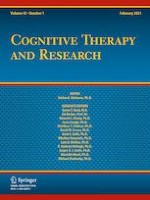03-10-2020 | Original Article
Frontal tDCS and Emotional Reactivity to Negative Content: Examining the Roles of Biased Interpretation and Emotion Regulation
Gepubliceerd in: Cognitive Therapy and Research | Uitgave 1/2021
Log in om toegang te krijgenAbstract
Background
Given findings showing that emotion regulation may be enhanced through prefrontal neurostimulation, the present study examined whether the effect of transcranial direct current stimulation on emotional reactivity is mediated via biased interpretation, and whether emotion regulation goals further moderate this relationship.
Methods
Healthy participants (n = 79) were allocated to one of four conditions to receive either active or sham tDCS concurrently with an emotion regulation task during which they were instructed to maintain or down-regulate their emotional reactions (between groups). A homograph priming task assessed biased interpretation, and emotional reactivity was assessed in response to a negative video viewing task.
Results
Those receiving active tDCS showed smaller elevations in negative mood in response to viewing negative videos compared to sham stimulation. Neither tDCS condition nor emotion regulation condition had an impact on interpretive bias, and there was no evidence for tDCS-enhancement of emotion regulation. As such, interpretive bias did not significantly mediate the relationship between tDCS and emotional reactivity, and no moderating role of emotion regulation was observed.
Conclusions
The present results are consistent with neural models implicating increased frontal activity with reduction in emotional reactivity, but provides no support for the role of interpretive bias in this relationship, and no evidence that tDCS enhanced the effects of emotion regulation.
